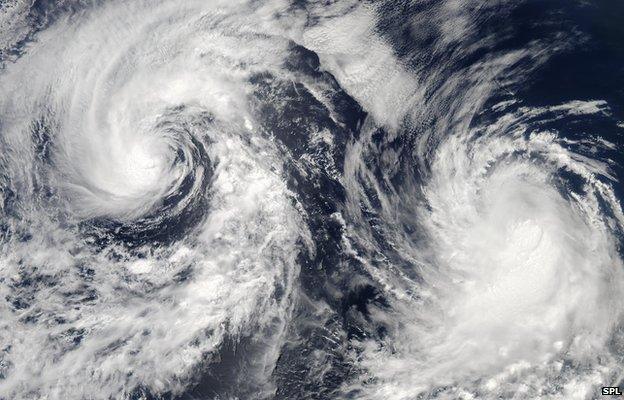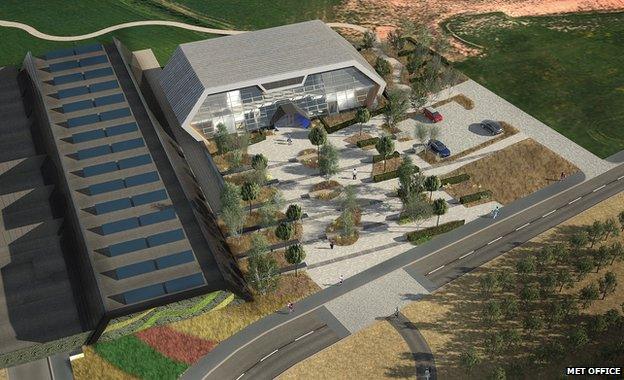Met Office to build £97m supercomputer
- Published
- comments

Funding has been confirmed for a £97m supercomputer to improve the Met Office's weather forecasting and climate modelling.
The facility will work 13 times faster than the current system, enabling detailed, UK-wide forecast models with a resolution of 1.5km to be run every single hour, rather than every three.
It will be built in Exeter during 2015 and become operational next September.
The Met Office said it would deliver a "step change" in forecast accuracy.
"It will allow us to add more precision, more detail, more accuracy to our forecasts on all time scales for tomorrow, for the next day, next week, next month and even the next century," said Met Office chief executive Rob Varley.
As well as running UK-wide and global forecasting models more frequently, the new technology will allow particularly important areas to receive much more detailed assessment.
For example, forecasts of wind speeds, fog and snow showers could be delivered for major airports, with a spatial resolution of 300m.
The extra capacity will also be useful for climate scientists, who need massive amounts of computing power to run detailed models over much longer time scales.
It will address one of the key challenges of climate projections - to "answer the real questions people need to know", said Mr Varley.
"We can tell you that the global average temperature is going to increase by 3C or 4C if we carry on as we are - but the critical question is what is that going to mean for London?
"What is it going to mean for Scotland? What is it going to mean for my back garden? At the moment the general looks that we can produce really don't answer those kinds of questions," he told BBC Radio 4's Today.

Analysis by David Shukman, BBC Science Editor
For an island nation that sits at a turbulent cross-roads between Atlantic moisture, Arctic cold and continental extremes, our weather is notoriously hard to forecast. Fickle winds, complicated topography and innumerable local influences add to the challenge.
The BBC's David Shukman says it will be "one of the world's fastest computers"
But because the weather matters so much - to everything from whether to leave home with a brolly to preparing for closed runways at an airport - all eyes are on the Met Office, and the glances are often hostile.
The biggest failures have now entered the national vocabulary: Michael Fish's denial of an approaching hurricane in 1987 and the infamous suggestion of a "barbecue summer" in 2009 when the reality proved relentlessly soggy.
The Met Office asserts that people never notice everyday successes, a gradual increase in reliability that has seen each decade allow the forecasts to reach another day into the future.
Rob Varley, Met Office, on how the supercomputer will change forecasting
The new supercomputer should accelerate that process, crunching bigger numbers at a finer scale and more frequently than ever before.
But it may also raise expectations about accuracy. And, in a country obsessed with the weather, that brings its own risks.

Mr Varley said he was "absolutely delighted" the government had confirmed its investment, which was first promised by the chancellor in the 2013 Autumn Statement.
The new system will be housed partly at the Met Office headquarters in Exeter and partly at a new facility in the Exeter Science Park, and will reach its full capacity in 2017.
At that point, its processing power will be 16 petaflops - meaning it can perform 16 quadrillion calculations every second.
The "Cray XC40" machine will have 480,000 central processing units or CPUs, which is 12 times as many as the current Met Office supercomputer, made by IBM. At 140 tonnes, it will also be three times heavier.
It marks the biggest contract the Cray supercomputing firm has secured outside the US.
"It will be one of the best high-performance computers in the world," Science Minister Greg Clark told journalists at the announcement, adding that it would "transform the analytical capacity of the Met Office".

The 140-tonne computer will be split between the Met Office and Exeter Science Park
Mr Clark said the supercomputer would put the UK, appropriately, at the forefront of weather and climate science. "It makes us world leaders not only in talking about the weather, but forecasting it too."
The improved forecasts, according to the Met Office, could deliver an estimated £2bn in socio-economic benefits, including more advance warning of floods, less air travel disruption, more secure decision-making for renewable energy investments, and efficient planning for the impacts of climate change.
Prof Tim Palmer, a climate physicist at the University of Oxford, also said the announcement was "very exciting news" and emphasised the necessity for more and more powerful computers.
"Unlike other areas of science, you can't really do lab experiments," he told the BBC. "We can only do two things: wait and see what happens, or try and simulate it inside a computer."
This means, Prof Palmer explained, "fantastically complex machines" like the XC40 - and whatever comes next.
"This is the start of an important investment, but it's by no means the endpoint."

Forecasting of fog, ice and snow at airports could be drastically improved
The most detailed climate simulations currently being proposed, Prof Palmer said, will need exabytes of storage: another vast increase on the capacity of the Cray XC40, which will have storage capacity of 17 petabytes (a petabyte is one million gigabytes; an exabyte is 1,000 petabytes).
Piers Forster, a professor of climate change at the University of Leeds, said the increased power should "massively improve understanding of extreme weather and climate change", but added: "We also need to support brain power.
"When the Met Office opened some of its computers to work with UK university academics it benefited everyone.
"These problems are too big for one computer or organisation to solve, but as long as our fruitful collaborations continue, we can realise the promised benefits."
Follow Jonathan on Twitter, external
- Published8 October 2014

- Published25 September 2014

- Published21 February 2012
